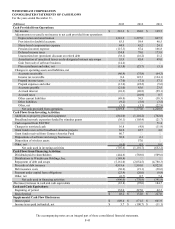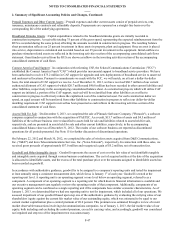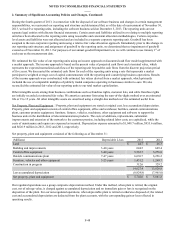Windstream 2013 Annual Report Download - page 186
Download and view the complete annual report
Please find page 186 of the 2013 Windstream annual report below. You can navigate through the pages in the report by either clicking on the pages listed below, or by using the keyword search tool below to find specific information within the annual report.
NOTES TO CONSOLIDATED FINANCIAL STATEMENTS
____
F-50
2. Summary of Significant Accounting Policies and Changes, Continued:
Operating Leases – Certain of our operating lease agreements include scheduled rent escalations during the initial lease term
and/or during succeeding optional renewal periods. We account for these operating leases in accordance with authoritative
guidance for operating leases with non-level rent payments. Accordingly, the scheduled increases in rent expense are
recognized on a straight-line basis over the initial lease term and those renewal periods that are reasonably assured. The
difference between rent expense and rent paid is recorded as deferred rent and is included in other liabilities in the
accompanying consolidated balance sheets. Leasehold improvements are amortized over the shorter of the estimated useful life
of the asset or the lease term, including renewal option periods that are reasonably assured.
Income Taxes – We account for income taxes in accordance with guidance on accounting for income taxes under the asset and
liability method. Deferred tax assets and liabilities are recognized for the estimated future tax consequences attributable to
differences between the financial statement carrying amounts of existing assets and liabilities and their respective tax bases.
Deferred tax balances are adjusted to reflect tax rates based on currently enacted tax laws, which will be in effect in the years in
which the temporary differences are expected to reverse. The effect on deferred tax assets and liabilities of a change in tax rates
is recognized in the results of operations in the period of the enactment date. A valuation allowance is recorded to reduce the
carrying amounts of deferred tax assets unless it is more likely than not that such assets will be realized. In addition, we
adopted authoritative guidance which addresses uncertainty in tax positions and clarifies the accounting for income taxes by
prescribing a minimum recognition threshold that the income tax positions must achieve before being recognized in the
financial statements.
Earnings Per Share – We compute basic earnings per share by dividing net income applicable to common shares by the
weighted average number of common shares outstanding during each period. Our non-vested restricted shares containing a
non-forfeitable right to receive dividends on a one-to-one per share ratio to common shares are considered participating
securities, and the impact is included in the computation of earnings per share pursuant to the two-class method. Calculations of
earnings per share under the two-class method exclude from the numerator any dividends paid or owed on participating
securities and any undistributed earnings considered to be attributable to participating securities. The related participating
securities are similarly excluded from the denominator.
Diluted earnings per share are computed by dividing net income applicable to common shares by the weighted average number
of common shares adjusted to include the effect of potentially dilutive securities. Potentially dilutive securities include
incremental shares issuable upon exercise of outstanding stock options and warrants. Options and warrants granted in
conjunction with the acquisition of PAETEC are included in the computation of dilutive earnings per share using the treasury
stock method. Diluted earnings per share exclude all potentially dilutive securities if their effect is anti-dilutive.
We also issue performance-based restricted stock units as part of our share-based compensation plan. These restricted stock
units contain a forfeitable right to receive dividends. Because dividends attributable to these shares are forfeited if the vesting
provisions are not met, they are considered non-participating restricted shares and are not dilutive under the two class method
until the performance conditions have been satisfied. The 2013 performance conditions for the outstanding restricted stock
units have been satisfied.
Options to purchase shares of stock issuable under stock-based compensation plans that were excluded from the computation of
diluted earnings per share because the exercise prices were greater than the average market price of our common stock and,
therefore, the effect would be anti-dilutive, totaled approximately 1.0 million shares for each of the years ended December 31,
2013, 2012 and 2011, respectively.
























